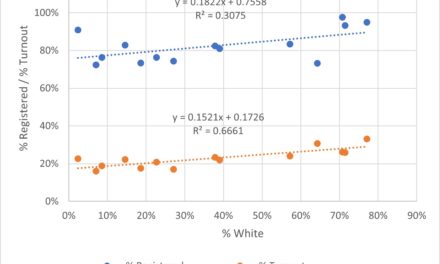As we pointed out last week, the rhetoric of Shelby County Schools officials often bears little resemblance to reality, whether the subject is growth, consolidation and academic achievement.
It’s a prime example of how if political rhetoric is loud and persistent enough, it often becomes reality. Frequently, no one, including the news media, bothers to determine the facts behind the rhetoric. While it is a political cliché that perception is reality, unfortunately, in the case of Shelby County Schools, perceptions drive decisions that increase the debt of Shelby County Government and continue questionable educational policies.
As we pointed out last week, the number of county students peaked in 1999 with 48,770 students. In fact, over a 10-year period, the enrollment of Shelby County Schools fell by 1.23 percent. In other words, county school enrollment is largely flat. Shelby County Schools’ fifth attendance period report puts enrollment now at 46,212.
Despite this, since 1999, Shelby County Schools has built 10 new schools and are lobbying for the money for even more. Already, it now has the Southeast Shelby high school and the Schnucks school under way.
There are a number of facts that will keep the county schools’ enrollment from growing as county school officials suggest. There are demographic trends like the aging of the Germantown population, movement of families outside of Shelby County, and in keeping with the agreements entered as part of the State Chapter 1101 process, county schools will be only those located within the various town limits.
The boundaries for 2010 result in Shelby County schools’ projected enrollment of less than 40,000. By 2015, enrollment will be about 35,000 and continue to decline to about 30,000 by 2020.
The impact on the ADA (Average Daily Attendance) funding formula will be profound. Now, Memphis City Schools has 73 percent of all public school students and Shelby County Schools has 27 percent. Therefore, funding for the two schools districts are split on the basis of their percentage of the total number of students.
By 2020, the breakdown will be about 82 percent city and 18 percent county. This means that if the present ADA formula is still in place, by 2020, $10 million needed for county schools will cost taxpayers $50 million, because city schools must get $40 million (because Memphis City Schools will have four times more students).
It is in this context that we predict that suggestions about school consolidation will become more and more seriously considered. While the idea triggers outrage from Shelby County Schools, it is hard to ignore the fact that every urban school district in Tennessee is now consolidated, except for Memphis City Schools and Shelby County Schools.
Among the many complaints leveled by county school officials, a favorite is that consolidation is more expensive. That’s not what a comparison of operating expenses for Tennessee urban counties shows.
In fact, it’s the unconsolidated school districts that have the largest increases in operating expenses over a 10-year period – 91.2 percent for Shelby County Schools and 94.7 percent for Memphis City Schools.
Meanwhile, increases for the consolidated urban districts are:
• Davidson County (Nashville) – 73.5 percent
• Hamilton County (Chattanooga) – 60.8 percent
• Knox County (Knoxville) – 64.9 percent
• Madison County (Jackson) – 50.2 percent
Roughly a year ago, Memphis Mayor Willie W. Herenton convened a task force to look into school consolidation, but it was essentially highjacked by county school interests, spending the intervening months writing a report on the intricacies of school funding. Statistics and experience indicate that consolidation is a policy option that now deserves serious study and consideration. Hopefully, the task force will now lead this process.
Also, a gap between rhetoric and reality is seen when county school officials talk about the performance of their schools. Repeatedly, county schools are held up as superior and high-performing. However, this conclusion is often reached as a result of a comparison of performance standards with Memphis City Schools.
Of course, the more pertinent – not to mention, fair – comparison would be for Shelby County Schools to compare itself with other suburban school districts characterized by two-parent, highly educated, higher income families. Lists of the best public schools in the U.S. regularly include schools from districts with the same profile as Shelby County Schools, but these lists never include a school from Shelby County Schools.
For example, just last week, the list of the top 1,000 U.S. schools was released, and they include schools from suburban districts outside Atlanta, Miami, Washington DC, Charlotte, and dozens of other major cities. But there’s not one school in the Shelby County School District among the 1,000 schools.
In Tennessee, there is the school in Brentwood (#339), in Oak Ridge (#360), in Franklin (#645) and Hillsboro School in Nashville (#812).
Shelby County has only one school. It’s in Memphis City Schools – White Station High, #621. In other words, in the school district with the highest expectations and greatest claims for student achievement, there is no school on the list.
But the list of 1,000 schools should not just be disturbing for Shelby County Schools. It should be a wake-up call for state government, too.
Hopefully, state education officials will not hold up five Tennessee schools among the 1,000 as indicators of successful educational policies. That’s because Florida has 20 schools in the top 100; North Carolina has 10 in the top 100; Texas has seven; and the #1 school in the U.S. is in Alabama.
Hopefully, someone in the Tennessee Department of Education will see these rankings for what they are — a challenge to business as usual. If other Southern states can create educational systems that inspire high-achieving schools, surely Tennessee can do the same.
And as state educational officials begin their deliberations, here’s hoping they ask Shelby County Schools to join in.



